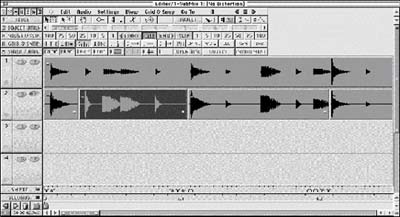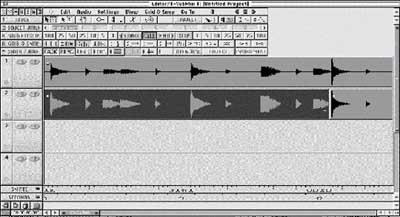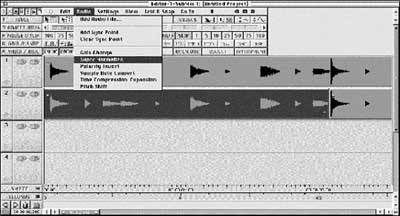By Craig Anderton
You want the highest average level possible on your CD. Why? Because everyone else does. In fact, there are a whole class of tools - compressors, normalizers, level maximizers, you name it - designed to do just that. After all, loud is good, right? Given two identical sound sources, people invariably identify the one that's slightly louder as better (consumer alert: when buying speakers in a stereo store, check whether the brand the store wants to push is slightly louder when compared against other speakers).
Frankly, I'm tired of recordings that use only the upper 6 dB of a CD's dynamic range. Dynamics should be a part of music, and I always thought part of the beauty of digital recording was its wide dynamic range. Silly me! Apparently, the point of digital recording is to be as loud as humanly possible.
However, there is a way to put some serious average level on a CD without totally destroying the dynamics. It takes a little more work, but try these techniques and see if they don't produce a result that's ultimately more satisfying than alternative methods.
But What's Wrong With Compression?
Electronic compression is useful; add some to a languid lead guitar track, and it can sound very cool. But while a subtle amount of limiting can definitely help during the mastering process, overcompressing an entire song can drain the life out of it. This is particularly the case with program material, where compressing loud sections alters the softer elements in those sections as well. If you're looking for an ultra-compressed sound, you're probably better off compressing each track individually and mixing them together compared to compressing the final stereo master. With PARIS, the best way to do this is to add compressors in the channel inserts.
However, there are still occasions where compressing an entire track improves the sound. One reason why people like analog tape so much is because it provides several benefits of compression without the side effects. Not only do signals gently saturate the type, there's some added harmonic interest that helps overcome the apparent loss of high frequencies often noted with single-band compressors. Nonetheless, tape has hiss, modulation noise, distortion, and all the other drawbacks that made people want digital in the first place. There must be a better way.
Why Normalization Alone Isn't Enough
Normalization is a fairly standard digital signal processing technique that scans through the program material for the highest level, and if that level doesn't reach the maximum available dynamic range, the program boosts the overall signal so that the peak hits the highest level possible. For example, suppose you record a track of music and the highest peak registers at 6 dB below the maximum available headroom. Normalization brings the entire track up by 6 dB. PARIS's standard normalization mode allows normalizing to less than the maximum available level if desired; I usually normalize to within 1 dB of maximum headroom.
There are two main limitations with standard normalization:
- Because normalization boosts the entire signal, the noise floor comes up as well.
- Normalization has nothing to do with a song's average level, only the peak level. Yet when balancing levels between tracks in the process of assembling a master tape, it is the average level that is usually most important. This is one reason why most mastering engineers recommend that you not normalize each individual song.
Despite these cautions, in many cases normalization can indeed help put the highest possible peak level on tape. But this won't help very much if the average level of a track is relatively low, yet there are one or two major peaks that hit the maximum available dynamic range. Fortunately, there are two answers: PARIS's Super Normalize function, and my own "Gourmet Normalization" technique, which is easy to do with PARIS as well.
Super Normalization
The Super Normalize function simply ignores some of the highest peaks, and clips them. But doesn't that create distortion? Yes, it does. But so does analog tape and overdriven vacuum tubes, yet many people actually prefer that type of sound. When mixing down to analog, if you hit the tape with lots of level, two things happen: the tape saturation "absorbs" spikes, and the lower-level signals seem pretty loud because you're feeding the tape with a hot signal. Clipping the spike does cause distortion, but as long as the clipping duration is short, it's not too much of a problem. For this reason, Super Normalization works best with percussive material that has a strong, short transient, then decays relatively rapidly.
PARIS has five Super Normalization options, from Most Strict (not too much clipping) to Most Relaxed (lots of clipping). If you want less or more distortion than the presets, you can produce an effect similar to Super Normalize by using the Gain Change option to increase the level to the point where it clips.
Fig. 1 shows a before-and-after example involving Super Normalization.
(image is 404 - a screenshot demonstrating this is welcome)
Fig. 1
The upper track shows a normalized drum sound using standard normalization. The lower track shows the same sound after processing through medium-level Super Normalization.
Gourmet Normalization
What if you want the benefits of Super Normalization without any distortion? It takes a little more work, but there is a solution.
First normalize a track, then locate the highest peak. Fig. 2 shows a drum track. The highlighted portion is much lower in level than the peak to its immediate right, and this peak prevents increasing the overall level any further. We're now about to normalize the highlighted area using standard normalization.

Fig. 2 - The highlighted area is about to be normalized.
Fig. 3 shows the post-normalized version of the drum track. Note how the average level is now dramatically higher.

Fig. 3 - The upper track shows the non-normalized sound; the lower track shows normalization applied only to a section that occurs before a peak that attains maximum headroom.
We can continue the normalization process on additional pieces of audio until the dynamic range is greatly reduced, and softer sounds are heavily boosted. Fig. 4 shows isolating and normalizing yet one more part of the drum sound.

Fig. 4 - The "gourmet normalized" drum track adds a lot more punch.
This technique also works very well for narration, where you normalize individual phrases to create a more uniform dynamic range.
© 1999, Craig Anderton. All Rights Reserved. Used by permission.
By his 22nd birthday, Craig Anderton had recorded three albums with the Philadelphia-based group "Mandrake Memorial," toured most of the USA, and played at Carnegie Hall. Craig is a prolific author, having written the classic work Home Recording For Musicians, several other books, and numerous articles for such magazines as EQ, Guitar Player, Keyboard, Musician, Performing Songwriter, Pro Audio Netherlands, and several others. He is currently Technology Editor for EQ magazine, Consulting Editor for Guitar Player magazine, and a monthly columnist for Keyboard.
© 2002 All Rights Reserved E-MU / ENSONIQ